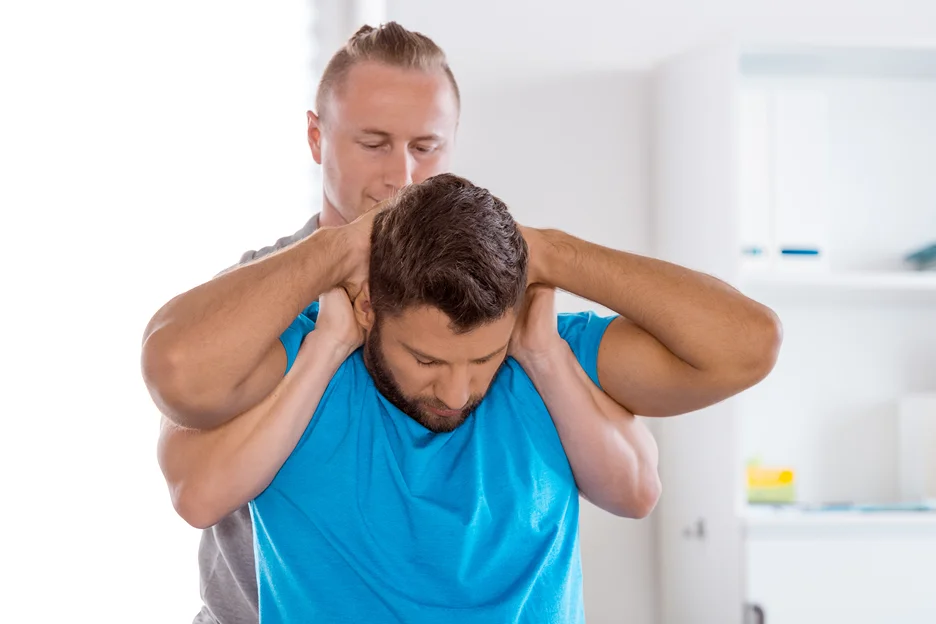Causes, Symptoms, and Treatments
Neck pain is an exceedingly common complaint, affecting up to two-thirds of the population at some point in their lives. While neck pain can arise from a variety of underlying issues, one of the most frequent culprits is tendonitis – inflammation of the tendons in the neck.
Tendonitis neck pain can greatly impact your daily life and mobility if left untreated. Arm yourself with information on the causes, symptoms, risk factors, and both self-care and medical treatment options for tendonitis neck pain.
What is Tendonitis and What Causes It?

Tendons are thick, fibrous cords that attach muscles to bones. They are crucial for enabling joint movements. Tendonitis occurs when these tendons become inflamed, often due to overuse or repetitive strain.
Common causes of tendonitis include:
- Sports that involve repetitive neck motions, like golf or tennis
- Occupations with frequent overhead reaching or heavy lifting
- Postural issues like slouching over phones and devices
- Prior neck injuries
- Natural wear and tear from aging
Tendonitis can also result from sudden injuries that overstretch the neck tendons. Auto accidents involving whiplash are a common cause of acute tendonitis.
Symptoms of Neck Tendonitis
The most pronounced symptom of neck tendonitis is pain and stiffness in the neck area. Those with tendonitis may experience:
| 1 | Deep, aching pain in the back of the neck, which may radiate out to the shoulders |
| 2 | Difficulty moving the neck through its full range of motion |
| 3 | Grating or crackling sensations when moving the neck |
| 4 | Mild swelling or tenderness in the affected tendons |
| 5 | Headaches originating at the base of the skull |
Severe tendonitis can make it quite painful to swallow. The duration of symptoms ranges from a few days for mild cases up to several weeks if left untreated.
Pay attention to any neck pain lasting more than a few days, especially if accompanied by stiffness and difficulty turning the head. Seek prompt medical advice for evaluation. Catching and treating tendonitis early can help prevent lasting damage.
Act Quickly to Prevent Lasting Damage From Tendonitis. Sign Up For Kaly Now!
Prevalence of Tendonitis in the Neck Region
Studies show that up to 70% of adults experience neck pain at some point in their lives. The neck contains intricately layered tendons that enable flexibility for head movements in all directions.
These tendons withstand the burden of continuous minor motions and adjustments made frequently throughout the day. According to research, poor posture caused by slouching over devices accounts for over 60% of neck tendonitis cases.
The tendons naturally weaken with age, increasing the risk of inflammation by 50% in people over 60. Prior injuries can also scar and weaken the tendons, making them up to 80% more likely to develop tendonitis in the future.
Proper workplace ergonomics, neck stretches, and strength training may help take pressure off the delicate neck tendons and decrease tendonitis risk. Paying attention to neck health is crucial given the region’s susceptibility to tendonitis.
How Is It Diagnosed?
If you are experiencing worrisome neck pain, consult your healthcare provider. They will ask about your symptoms and perform a physical exam of your neck.
Moving your neck in different directions can reveal decreased range of motion or painful, limited movements that signal tendonitis.
Your provider may order imaging tests such as:
- X-rays to assess the neck bones and check for arthritis or other issues.
- MRI scans to look at soft tissue and check for inflammation of the tendons.
- Ultrasounds to view the tendons in motion and identify any tears.
Blood tests may also be done to check for underlying conditions. Based on the exam and test findings, your doctor can confirm if tendonitis is the cause of your neck pain.
Treatments for Neck Tendonitis

The good news is there are many effective treatment options for relieving neck tendonitis. Specific treatments your doctor may recommend include:
Rest
Avoiding activities that aggravate your neck pain allows the inflamed tendons to heal. Your doctor may prescribe a soft neck brace to immobilize the area. Take frequent breaks at work and limit activities requiring neck motion.
Ice/Heat
Applying ice for 15 minutes a few times per day helps control inflammation and pain. After the first few days, use alternating heat as well to increase blood flow and relax muscles.
Medications
Over-the-counter nonsteroidal anti-inflammatories (NSAIDs) like ibuprofen and naproxen can ease pain and swelling. For severe cases, prescription NSAIDs or mild narcotics may be prescribed.
Physical Therapy
Once pain decreases, physical therapy helps restore range of motion, flexibility, and strength through targeted exercises. Therapists can also utilize manual techniques to improve joint mobility.
Steroid Injections
If other measures do not provide relief, your doctor may inject corticosteroids directly into the inflamed tendon to reduce swelling and pain. However, potential risks exist with steroid injections.
Surgery
This is rarely needed except for individuals with chronic tendonitis uncontrolled by other treatments. Options range from removing damaged tissue to repairing tears.
In most cases, a combination of rest, medication, and physical therapy resolves symptoms within a few weeks. Work closely with your healthcare provider to determine the appropriate treatment plan for your situation.
End Tendonitis Agony – Experts on Kaly Will Match You to the Right Neck Treatment Fast
How Physical Therapy Helps Treat Neck Tendonitis
Physical therapy offers many benefits for recovering from neck tendonitis:
- Hands-on techniques like massage, trigger point therapy, and joint mobilization performed by a physical therapist can relax tight musculature, improve range of motion, and decrease pain.
- Specific strengthening exercises will be prescribed to improve stability and posture. Weak neck muscles often contribute to tendonitis.
- Your physical therapist will guide you through controlled stretching and mobility exercises to restore full neck function. Special equipment like foam rollers may be used.
- Ultrasound, ice, heat, and other modalities can be applied by your therapist to accelerate healing.
- Your therapist will correct any postural issues or biomechanical dysfunction contributing to your neck tendonitis.
- You will receive instructions for continuing your rehabilitation exercises and proper neck mechanics at home between sessions.
Research confirms physical therapy is highly effective for relieving neck pain from tendonitis and other common sources. It can speed recovery and often reduce the need for risky pain medications.
Tips to Prevent Neck Tendonitis
While there is no foolproof way to prevent neck tendonitis entirely, you can reduce flare-ups and discomfort by taking proactive steps to care for your neck.
With some simple lifestyle adjustments and smart self-care, you can keep your neck muscles and tendons healthy and hopefully avoid severe neck tendonitis. These include:
| Helpful Tips to Prevent Neck Tendonitis | |
| 1 | Maintaining proper posture at work and when using phones and computers. |
| 2 | Avoiding slouching and positioning your screens at eye level to keep your neck straight. |
| 3 | Taking frequent breaks when performing repetitive tasks to give your neck muscles a rest. |
| 4 | Strengthening your neck and upper back muscles through exercise to better support your head. |
| 5 | Warming up properly with stretches before sports or strenuous activity involving the neck. |
| 6 | Recovering fully after any prior neck injuries before resuming activity. |
| 7 | Getting prompt treatment for any neck injuries or persistent pain that arises. |
| 8 | Having your workstations, desks, chairs and car seats adjusted properly to align your spine and support good posture. |
| 9 | Using good mechanics when lifting heavy objects, avoiding jerking or straining motions. |
| 10 | Managing stress and mental tension which can manifest in tight neck muscles. Relaxation techniques help. |
| 11 | Receiving occasional massages to loosen up neck tension. Use warm compresses and perform gentle stretches daily. |
| 12 | Maintaining a healthy weight to avoid placing excess strain on the neck. |
| 13 | Ensuring you get adequate calcium and vitamin D for bone and muscle health. |
With some mindfulness about posture and diligence with proper strengthening and stretching, neck tendonitis can often be avoided.
But if it does occur, early diagnosis and treatment is key to preventing it from becoming a chronic problem.
Take Control of Your Tendonitis Neck Pain

Dealing with neck pain and stiffness from tendonitis can be frustrating. But knowledge is power – arm yourself with information on the causes, treatments, and prevention tips for tendonitis neck pain.
While over-the-counter medications and at-home care can help ease symptoms initially, consult a doctor if your neck pain persists or worsens. An accurate diagnosis is essential, as the treatment approach differs depending on the source of neck pain.
Don’t let tendonitis neck pain slow you down. Seek care from providers you can trust and get back to pain-free movement. Kaly connects patients seamlessly with experienced doctors, physical therapists, and other healthcare experts dedicated to resolving your neck issues properly.
Sign up for today to find and instantly book appointments with top-rated neck pain specialists in your area. Kaly also offers virtual video visits for your convenience.
Don’t live with the ache – let the experts at Kaly help guide you on the path back to a healthy, mobile neck.
